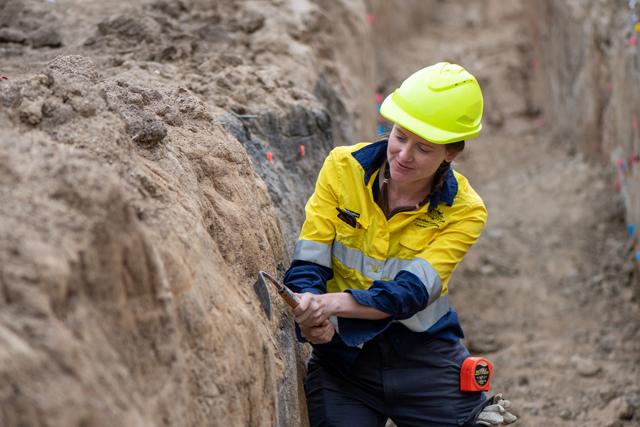18 June 2024–Tamarah King, is there a question you hear often about Australian seismicity?
“If I had a dollar for every time somebody told me ‘Australia doesn’t have earthquakes!’” King said. “Not just from the general populace, I regularly meet earthquake scientists who are genuinely surprised to hear about Australia’s record of earthquakes.”
“In relative terms, Australia’s seismic hazard is pretty low. As an example, when comparing like-for-like, the highest forecast hazard for Australia is roughly equivalent to New Zealand’s lowest forecast hazard,” she explained. “But that doesn’t mean we have no seismic hazard, just much lower in relative terms.”
King is a seismic hazard scientist within the Community Safety Branch of Geoscience Australia. The branch contains Australia’s earthquake monitoring team, tsunami warning center, the observational team that looks after the national seismic and geomagnetic networks, and groups working on other risks such as wind hazard.
“Our seismic hazards team is responsible for producing the National Seismic Hazard Assessment (NSHA) for Australia, on a roughly five-year cycle,” King said. Her day-to-day work is mostly behind a desk, with occasional fieldwork, working on the national scale seismic hazard products and research, assisting state and territory emergency managers, and doing on-call shifts to support Australia’s 24/7 earthquake monitoring.
People are often surprised to hear that Australia has had fatal and highly damaging earthquakes like the 1989 magnitude 5.4 Newcastle earthquake that killed 13 people and is Australia’s third most costly natural disaster on record, King said. “Earthquakes of similar or higher magnitudes on average occur every one to two years somewhere in Australia. We’ve been lucky that most of these have occurred away from population centers. However, the potential for these events to occur in populated locations is what our seismic hazard modeling focuses on.”
King came to seismology in a roundabout way. She fell in love with geology accidentally, she said, “in awe of my professors who could pick up a rock or look at a landscape and tell incredible stories about Earth’s history. So that’s how I got hooked into my bachelor and master’s degrees in geology.”

Between her master’s and Ph.D. degrees, King spent a year in central Java, “where the science and impact of earthquakes was an everyday part of life,” she said. She had planned a Ph.D. on Australian tectonic geomorphology, but six days before she was preparing to leave for fieldwork in remote central Australia, the magnitude 6.1 Petermann earthquake occurred about 300 kilometers from her planned field site.
It was “an incredible coincidence in a country the size of Australia,” she recalled. “With the car already packed, our brand-new research drone on board, and a very high chance of surface rupture, we headed straight out to the Petermann and the rest is history—or rather, my Ph.D.”
“From that point to now, I’ve felt like an alchemist mixing my geological training in structural geology and tectonics with paleoseismicity, seismology, and geophysics,” said King.
King said Twitter, “which unfortunately doesn’t have the same community these days,” offered her global networking and scientific updates that were hard to come by in Australia during her Ph.D.
“It gave me the opportunity to see paleoseismic trenches, earthquake effects, and seismological analysis from across the world—and as the saying goes, ‘the best geologist is the one who’s seen the most rocks,’” she said. “It also allowed me to interact with lived experiences across intersectional diversity categories that I might otherwise not know much about.”
Twitter also led King to become an instructor for She Maps, a company dedicated to STEM education using drones as a teaching tool. As part of She Maps, King traveled to community groups and schools across Australia. “Through that experience I gained a huge amount of teaching and engagement experience, and ended up on children’s TV, in a children’s book, and voicing a cartoon character in an educational game app,” she said. “It was invaluable for learning to talk about my science across a broad spectrum of society.
King said she has “a million big and small dream projects” related to Australian seismic hazard. “I have to confess, I get jealous at the length of author lists in places like New Zealand and the USA, just imagining what we could accomplish with similar numbers of scientists! There is a fantastic group of earthquake scientists in Australia but we’re fairly limited in how much we can achieve with modest numbers and the scale of the continent and questions at hand.”
“My number one overarching scientific question is consistently ‘why does Australia–and similar locations–have earthquakes?’ We have plenty of likely explanations and models, but to my mind they’re fairly patchwork compared to the unifying theory of plate tectonics and elastic rebound which describe plate boundary earthquakes,” she added. “I’d really like to have a defensible and unifying theory to point to whenever an earthquake happens to say ‘look! This is why it happened there.’ And even better if we can also say ‘and that’s why it happened then.’”
SSA At Work is a monthly column that follows the careers of SSA members. For the full list of issues, head to our At Work page.
